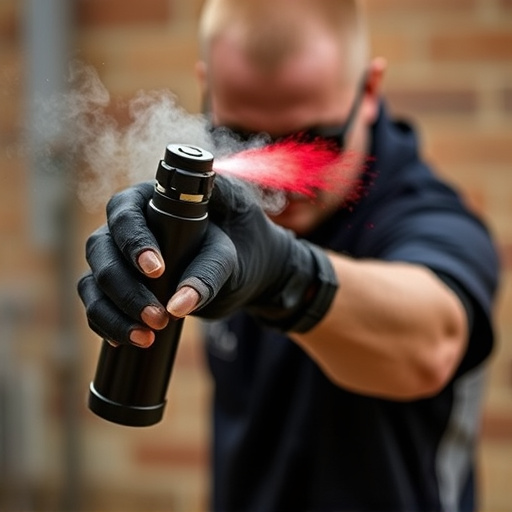Pepper spray, specifically designed for dog attacks, uses capsaicin from chili peppers to temporarily disable through nerve stimulation. Formulations often include lactic acid and preservatives for enhanced stability. Police-grade pepper spray offers a critical defense against aggressive dogs, causing temporary blindness and irritation, allowing individuals time to escape or de-escalate the situation. Effective application techniques involve targeting sensitive areas at arm’s length with short bursts, while adhering to strict legal regulations and responsible use protocols.
“Uncovering the power of police-grade inflammatory pepper spray, a versatile tool in personal defense against aggressive dogs. This comprehensive guide explores its composition, from capsaicin concentration to solvent choice, and how these factors impact effectiveness. We delve into its role in dog defense scenarios, offering insights on application techniques for optimal results while ensuring safety. Additionally, we navigate legal considerations and responsible use guidelines, emphasizing the importance of understanding both the spray’s capabilities and limitations.”
- Understanding Pepper Spray: Its Composition and Effects
- The Role of Police-Grade Pepper Spray in Dog Defense
- Application Techniques: Ensuring Effectiveness and Safety
- Legal Considerations and Responsible Use Guidelines
Understanding Pepper Spray: Its Composition and Effects
Pepper spray, a powerful defense tool against dogs and other potential threats, is a compound designed to incapacitate temporarily through irritation. Its primary active ingredient is capsaicin, extracted from chili peppers, which stimulates nerve endings in the eyes, nose, and throat, leading to pain, coughing, and difficulty breathing. This natural compound is potent—a tiny amount can stop an aggressive dog in its tracks, giving the user precious time to escape or seek help.
The spray’s composition goes beyond capsaicin. It often includes other chemicals like lactic acid and various preservatives that enhance its effectiveness and stability. These additional components ensure that pepper spray remains potent under a variety of conditions, making it a reliable defense mechanism whether in urban settings or during outdoor activities where dogs might be present. Understanding these compositions is crucial for anyone considering pepper spray as a personal safety measure, especially when faced with the potential threat of dog attacks.
The Role of Police-Grade Pepper Spray in Dog Defense
In the realm of personal defense, police-grade inflammatory pepper spray has proven to be a game-changer. When facing aggressive dogs, pepper spray can serve as a crucial defense mechanism for individuals seeking to protect themselves. The compound’s ability to cause temporary blindness and severe irritation in the eyes and respiratory system gives users valuable time to escape or de-escalate the situation.
The effectiveness of pepper spray defense against dogs lies in its swift action. Upon contact, the spray disrupts the dog’s sense perception, slowing its reaction time and allowing the target to retreat safely. This strategic tool is particularly useful in situations where traditional self-defense methods may not be feasible or effective against larger breeds. By utilizing police-grade pepper spray, individuals can gain control of a potentially dangerous encounter with dogs, ensuring their safety until help arrives.
Application Techniques: Ensuring Effectiveness and Safety
When using pepper spray as a defense against dogs, understanding application techniques is paramount to ensure its effectiveness and safety. It’s crucial to aim for the dog’s eyes, nose, and mouth—sensitive areas that will neutralize its senses and temporarily disable it. Hold the canister at arm’s length and use short, controlled bursts, allowing the spray to dissipate before applying more. This technique prevents wind or environmental factors from blowing the spray back towards you.
Proper timing and distance are also key. Apply the spray when the dog is in close proximity but not yet attacking. Maintain a safe distance to avoid any potential backlash from the spray’s irritants. Remember, pepper spray is designed to disrupt an aggressor’s ability to breathe and see temporarily, giving you time to escape or summon help. Consistent practice of application techniques will ensure you’re prepared should you ever need it as a defense against dogs.
Legal Considerations and Responsible Use Guidelines
In many jurisdictions, the possession and use of inflammatory pepper spray are strictly regulated to ensure public safety and prevent misuse. These legal considerations extend to the specific compound used in Pepper Spray Defense Against Dogs, which must adhere to strict guidelines for formulation and deployment. Authorities often mandate that only law enforcement agencies or trained professionals can legally employ such sprays to control aggressive animals or maintain public order during disturbances.
Responsible use guidelines emphasize the necessity of proportionality and caution. Pepper spray should be a last resort when other de-escalation techniques prove ineffective. Officers are trained to administer the spray with precision, aiming for non-lethal impact areas to minimize collateral damage and ensure the safety of both civilians and animals involved. Moreover, proper storage and disposal methods are crucial to prevent unauthorized access and environmental contamination.
Pepper spray, particularly its police-grade formulation, offers a powerful tool for self-defense against aggressive dogs. By understanding the compound’s composition and effects, mastering application techniques, and adhering to legal guidelines, individuals can effectively utilize pepper spray as a last resort when facing a dog attack. While not without limitations, responsible use of pepper spray in such scenarios can provide crucial time for escape or assistance, ultimately enhancing personal safety during encounters with potentially dangerous canines.
